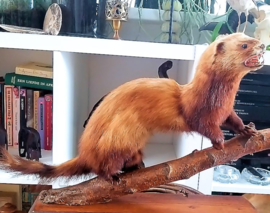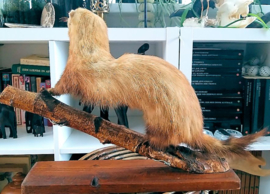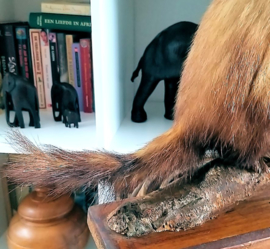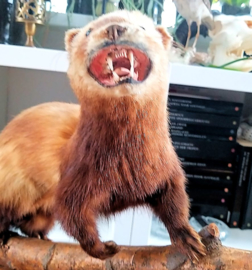Taxidermie: Mooie Grote Polecat/Bunzing op Tak + Basis
Mooie grote opgezette Bunzing/Polecat - Mustela putorius
- Deze bunzing is een natuurlijke dood gestorven en in circa 1950 in België opgezet. (non CITES)
- Prachtige, grote mannelijke polecat. Zit nog goed in zijn vacht (mooi en zacht) - Staart is netjes - klauwen zijn goed - zie alle foto's.
- Ik vermoed dat dit eerst een muurbevestiging was (op de dikke tak) - waar later de eiken plank onder is gemaakt. Nu staat hij stevig op de grond/een kast.
- Totaal formaat: ca 52x34x15 cm (52 cm lang - 34 cm hoog) - 1080 gram
De bunzing (Mustela putorius) is een roofdier dat behoort tot de familie marterachtigen (Mustelidae). Het is een van de zeven inheemse soorten marterachtigen in België en Nederland. De bunzing komt voor in grote delen van Europa tot in westelijk Azië en uiterst noordwestelijk Afrika.
De bunzing is naaste familie van de wezel en de hermelijn. Over het algemeen zijn de drie soorten goed te onderscheiden, maar er komen soms kleurvariaties voor die de identificatie bemoeilijken. De bunzing is daarnaast de wilde voorvader van de fret (Mustela putorius furo), die als een ondersoort wordt beschouwd. Het is een echte bodembewoner die veel graaft en niet vaak klimt.
De bunzing werpt eenmaal per jaar jongen, dit zijn er ongeveer vijf per keer. Na vier maanden zijn ze zelfstandig en na zes maanden zijn ze volwassen. De bunzing wordt ongeveer vier jaar oud. De bunzing is een zeer actief roofdier dat leeft van prooien als kleine tot middelgrote gewervelde dieren zoals konijnen en vogels. Er worden voedselvoorraden aangelegd. Ook geleedpotige dieren en fruit worden soms gegeten.
Vijanden zijn andere roofdieren zoals slangen en vossen. De mens heeft een negatieve invloed op de bunzing, voornamelijk doordat vele dieren worden doodgereden door het verkeer. De bunzing wordt beschouwd als een algemeen voorkomende marterachtige die niet wordt gezien als bedreigd, in tegenstelling tot verwante soorten zoals de nerts. De bunzing wordt wel beschouwd als een nuttig dier vanwege de gewoonte om op knaagdieren te jagen.
Taxidermy: Beautiful large, male Polecat - Mustela putorius
- This Polecat died around 1950 of natural causes in Belgium. (non CITES)
- Beautiful large male. Good, soft fur. Tail & claws are good. See all photos.
- Size: about 52x34x15 cm cm (length 52 cm - height 34 cm) - weigths 1080 grammes in total
The European polecat (Mustela putorius) is a species of mustelid native to western Eurasia and north Morocco. It is of a generally dark brown colour, with a pale underbelly and a dark mask across the face. Occasionally, colour mutations, including albinos and erythrists, occur.] Compared to minks and other weasels – fellow members of the genus Mustela – the polecat has a shorter, more compact body; a more powerfully built skull and dentition; is less agile; and it is well known for having the characteristic ability to secrete a particularly foul-smelling liquid to mark its territory.
It is much less territorial than other mustelids, with animals of the same sex frequently sharing home ranges. Like other mustelids, the European polecat is polygamous, with pregnancy occurring after mating, with no induced ovulation. It usually gives birth in early summer to litters consisting of five to 10 kits, which become independent at the age of two to three months. The European polecat feeds on small rodents, birds, amphibians and reptiles. It occasionally cripples its prey by piercing its brain with its teeth and stores it, still living, in its burrow for future consumption
The European polecat originated in Western Europe during the Middle Pleistocene, with its closest living relatives being the steppe polecat, the black-footed ferret and the European mink. With the two former species, it can produce fertile offspring, though hybrids between it and the latter species tend to be sterile, and are distinguished from their parent species by their larger size and more valuable pelts.
The European polecat is the sole ancestor of the ferret, which was domesticated more than 2,000 years ago for the purpose of hunting vermin. The species has otherwise been historically viewed negatively by humans. In the British Isles especially, the polecat was persecuted by gamekeepers, and became synonymous with promiscuity in early English literature. During modern times, the polecat is still scantly represented in popular culture when compared to other rare British mammals, and misunderstandings of its behaviour still persist in some rural areas. As of 2008, it is classed by the IUCN as Least Concern due to its wide range and large numbers.










